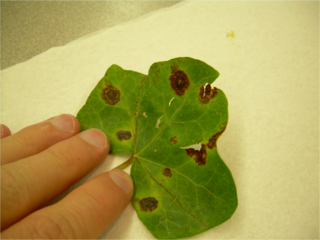
The Xanthomonadales are a bacterial order within the Gammaproteobacteria. They are one of the largest groups of bacterial phytopathogens, harbouring species such as Xanthomonas citri, Xanthomonas euvesicatoria, Xanthomonas oryzae and Xylella fastidiosa. These bacteria affect agriculturally important plants including tomatoes, bananas, citrus plants, rice, and coffee. Many species within the order are also human pathogens. Species within the genus Stenotrophomonas are multidrug resistant opportunistic pathogens that are responsible for nosocomial infections in immunodeficient patients.

Aspergillus is a genus consisting of several hundred mold species found in various climates worldwide.

Rhizopus is a genus of common saprophytic fungi on plants and specialized parasites on animals. They are found in a wide variety of organic substances, including "mature fruits and vegetables", jellies, syrups, leather, bread, peanuts, and tobacco. They are multicellular. Some Rhizopus species are opportunistic human pathogens that often cause fatal disease called mucormycosis. This widespread genus includes at least eight species.

Aspergillus oryzae is a mold used in East Asia to saccharify rice, sweet potato, and barley in the making of alcoholic beverages such as sake and shōchū, and also to ferment soybeans for making soy sauce and miso. It is one of the different koji molds ニホンコウジカビ (日本麹黴) used for food fermentation.

Oryza longistaminata is a perennial species of grass from the same genus as cultivated rice. It is native to most of sub-Saharan Africa and Madagascar. It has been introduced into the United States, where it is often regarded as a noxious weed. Its common names are longstamen rice and red rice.
Luttrellia is a genus of fungi in the family Halosphaeriaceae. The genus contains four species.
Khuskia is a fungal genus in the class Sordariomycetes. The relationship of this taxon to other taxa within the class is unknown. A monotypic genus, it contains the single species Khuskia oryzae, described as new to science in 1963.

The suffix -bacter is used in microbiology for many genera and is intended to mean "bacteria".

The Magnaporthaceae are a family of fungi in the order Magnaporthales. It was circumscribed by Paul F. Cannon in 1994 for a group of grass-associated fungi centered on Magnaporthe (Nakataea). Magnaporthaceae have a harpophora-like asexual morphology and are often associated with roots of grasses or cereals.
Acidovorax oryzae is a bacterium from the Comamonadaceae family which is closely related to Acidovorax citrulli. Acidovorax oryzae was reclassificated from the former name Acidovorax avenae subsp. avenae. It has been shown that Acidovorax oryzae is serious pathogen fore rice.
Azospira oryzae is a species of bacteria. It is a root bacteria, one of two species in the genus Azospira along with A. restricta.

Xanthomonas oryzae pv. oryzae is a bacterial pathovar that causes a serious blight of rice, other grasses, and sedges.

Rhizopus oryzae is a filamentous heterothallic microfungus that occurs as a saprotroph in soil, dung, and rotting vegetation. This species is very similar to Rhizopus stolonifer, but it can be distinguished by its smaller sporangia and air-dispersed sporangiospores. It differs from R. oligosporus and R. microsporus by its larger columellae and sporangiospores. The many strains of R. oryzae produce a wide range of enzymes such as carbohydrate digesting enzymes and polymers along with a number of organic acids, ethanol and esters giving it useful properties within the food industries, bio-diesel production, and pharmaceutical industries. It is also an opportunistic pathogen of humans causing mucormycosis.
Mucilaginibacter oryzae is a Gram-negative and non-spore-forming bacterium from the genus of Mucilaginibacter which has been isolated from rhizosphere soil from a rice plant in Jinju in Korea.
Streptomyces oryzae is a bacterium species from the genus of Streptomyces which has been isolated from the stem of a rice plant Oryza sativa.
Weissella oryzae is a Gram-positive bacterium from the genus of Weissella which has been isolated from fermented Japanese rice from Tochigi Prefecture in Japan.
Flexivirga oryzae is a Gram-positive, strictly aerobic and non-motile bacterium from the genus Flexivirga which has been isolated from soil from a rice field from Korea.

Tritirachium oryzae is a fungus in the Basidiomycota often mistaken for a member of the Ascomycota. it is a mesophile linked recently with human pathogenicity in multiple, rare cases. This species produces airborne spores and is an endophyte of several plant species in North America, South America and in the Middle East.
Intrasporangium is a genus of Gram positive, nonmotile bacteria. The genus name refers to the mycelium of the type strain forming intercalary vesicles that were originally identified as spores. However, no spores have been observed in later studies. The family Intrasporangiaceae is named after the genus, and Intrasporangium is the type genus for the family.
Intrasporangium oryzae is a species of Gram positive, strictly aerobic bacterium. The species was initially isolated from rice paddy soil. The species was first described in 2007, and its name is derived from Latin oryzae. It was originally placed in the novel genus Humihabitans, but further research reclassified the species as a member of the existing genus, Intrasporangium. Because Humihabitans was monospecific, with H. oryzae as the only species, the genus is now defunct.









